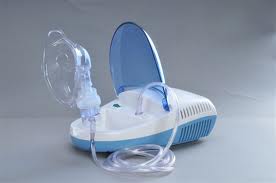Nebulizer

In the medical field, a nebulizer (also spelled nebuliser in British
English) is a device utilized to administer medication in the form of a mist
that is inhaled into the lungs. Nebulizers find common application in the
treatment of conditions such as cystic fibrosis, asthma, COPD, and various
other respiratory ailments.
Nebulizers employ oxygen, compressed air, or ultrasonic power to disperse
medical solutions and suspensions into minute aerosol droplets that can be
directly inhaled through the device's mouthpiece.
An aerosol is defined as a "mixture of gas and liquid particles," with mist
being a prime example of a naturally occurring aerosol. Mist forms when
small water vapor particles in hot ambient air cool and condense into fine
visible airborne water droplets.
During inhalation therapy with a nebulizer, it's essential to note that
aerosol droplets must have a diameter of 1-5 micrometers to penetrate into
the narrow branches of the lower airways effectively. Otherwise, they are
only absorbed by the oral cavity, resulting in diminished effectiveness.
The most prevalent type of nebulizers is Jet nebulizers, often referred to
as "atomizers." These nebulizers are linked to a compressor via tubing,
which generates compressed air or oxygen flow at high velocity through a
liquid medication to produce an aerosol, subsequently inhaled by the
patient. While there's a growing preference among physicians for prescribing
pressurized Metered Dose Inhalers (pMDI) over Jet nebulizers due to their
quieter operation and lighter weight, Jet nebulizers remain widely used in
hospital settings, especially for patients facing challenges with inhaler
use, such as in severe respiratory diseases or asthma attacks.
Jet nebulizers offer the advantage of low operational costs. For patients
requiring daily inhalation therapy, the expense of using a pMDI can be
considerable. Some manufacturers have succeeded in reducing the weight of
Jet nebulizers to as low as 635 grams (22.4 oz), labeling them as portable
devices. However, despite advancements, noise and weight remain significant
drawbacks of Jet nebulizers compared to other inhalers and nebulizers.
Nebulizers administer medication in the form of a liquid solution, typically
loaded into the device before use. Corticosteroids and bronchodilators like
salbutamol (albuterol USAN) are commonly utilized, sometimes combined with
ipratropium. Inhaling these medications targets their effects to the
respiratory tract, hastening onset of action and reducing side effects
compared to alternative intake routes.
The aerosolized medication is usually inhaled through a tube-like
mouthpiece, akin to inhalers. Alternatively, a face mask similar to those
used for inhaled anesthesia may be used, especially with young children or
the elderly, although mouthpieces are preferred when feasible to minimize
aerosol losses in the nose.
After corticosteroid use, patients may theoretically develop thrush (yeast
infection in the mouth) or dysphonia (hoarseness of voice), though these
occurrences are clinically rare. To mitigate these adverse effects,
clinicians may advise patients to rinse their mouths after nebulizer use.
This isn't necessary for bronchodilators, though patients may still opt to
rinse due to the unpleasant taste of certain bronchodilating drugs.
undo Medical Equipment